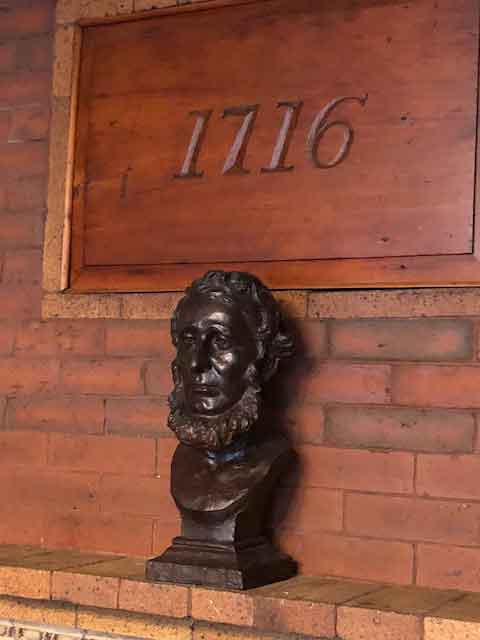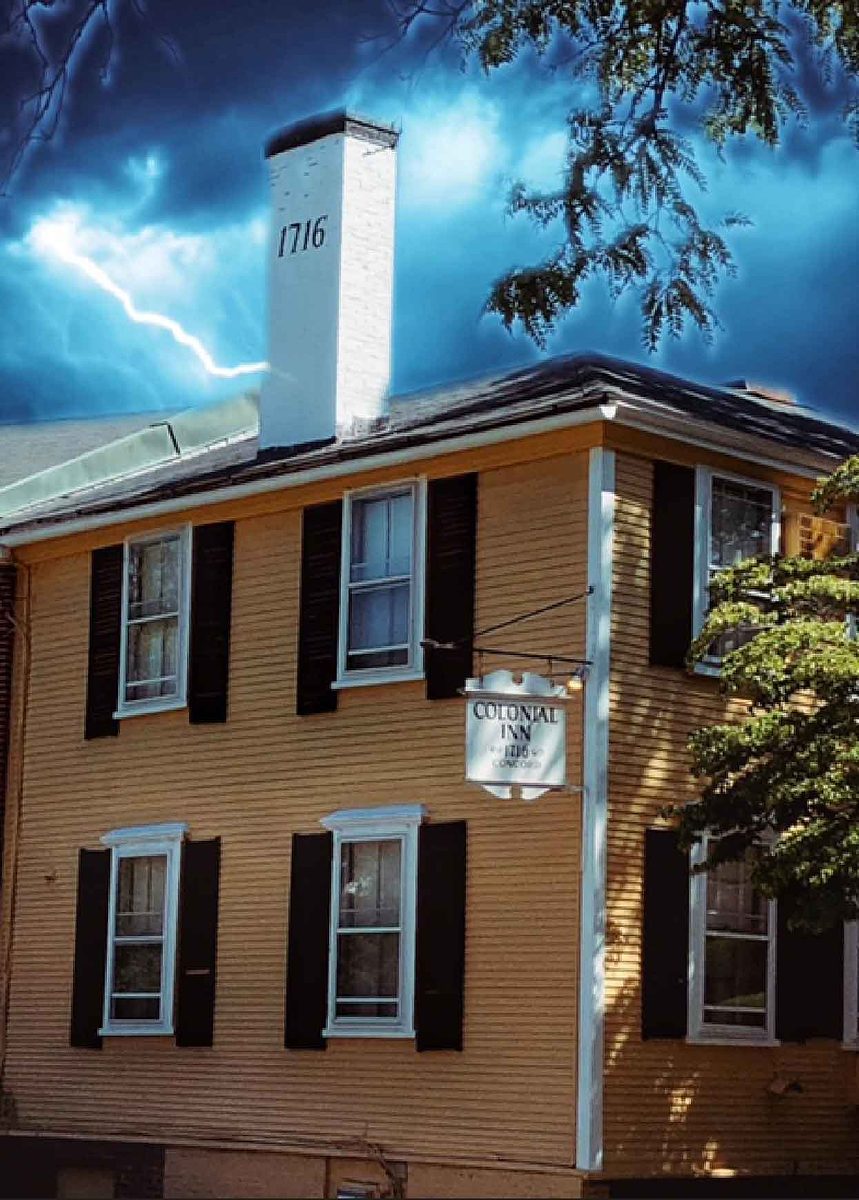“When you have eliminated the impossible, whatever remains, however improbable, must be the truth.” - Sherlock Holmes (creation of Sir Arthur Conan Doyle, writer, and paranormal investigator)
There are some tales that have so seeped into a place that it is best to leave them be or risk upsetting the spirits who dwell within. But sometimes, even if you mind your own realm, the spirits come out and find you. Such is the case in Concord’s Colonial Inn, which sits in the town center overlooking Monument Square.
The Colonial Inn tops the Historic Hotels of America’s list of Most Haunted Historic Hotels. Television shows such as Ghost Hunters have filmed episodes in the Inn, and professional paranormal investigators and enthusiasts continue to be drawn here by reports of unusual happenings, such as disembodied voices, glimpses of ghostly children roaming the halls, apparitions of Revolutionary War era soldiers, blinking lights, and banging noises in empty rooms. But how did the Inn, the home of these spirits, get here, and what summoned them here?
To find out, we travel back through the mists of time to the town of Saffron Walden in England, where we find ourselves surrounded by a haze of smoke rising from a dreadful funeral pyre. The year is 1555; “Bloody Mary,” the eldest daughter of the recently deceased King Henry VIII, is now Queen of England and wreaking revenge across the country, burning Protestants at the stake as she tries to restore the Catholic faith her father rejected when he divorced her mother and proclaimed himself the head of the Church of England. In Mary’s reign, over 300 protestants are burned alive, including in Saffron Walden. Previously known as “Weala-denu” (the Old English word for “Valley of the Britons’’) the town gained fame in the 1400s for its cultivation of the saffron plant whose dye produced the royal purple color seeped into fabrics worn by kings, queens, and aristocrats, and the town name was modernized to Saffron Walden.
In this community, wearing the simple garb of yeoman, we find members of the family Minot. Church records show that they, too, had joined King Henry’s Church of England but, luckily for them, seemed to have escaped the wrath of Bloody Queen Mary. By the early 1630s, King Charles I was heavy-handedly ruling, and an English Civil War was brewing. In the upheaval, thousands of English families began sailing for the new world. Among them, from Saffron Walden, came George Minot. It is believed that Minot and his young family landed in the Massachusetts Bay Colony in 1633 and settled in Dorchester.
Shortly behind them, in 1635, aboard the Susan & Ellen, escaping from King Charles I’s religious restrictions on Puritans, traveled Puritan minister Peter Bulkeley. Upon arrival, Reverend Bulkeley forged inland and became one of the founders of Concord, Massachusetts. Bulkeley owned many properties around the town center, some of which his widow sold in 1660 to another early Concord settler, Timothy Wheeler. Twenty years later, Timothy Wheeler’s daughter, Rebecca, married George Minot’s grandson, James Minot, when he moved to Concord to work as a doctor, minister, and justice of the peace. When Timothy Wheeler died, James and Rebecca inherited some of the land he had purchased from Bulkeley’s widow and, sometime before 1716, they likely built the first home on the property. This structure would become the oldest part of today’s Colonial Inn. If you look at the front of the Inn today, it is the section to the right on the east side of the building.
 ©Jaimee Joroff
©Jaimee JoroffJames willed the house to his son, James Minot II, a lieutenant colonel in the French and Indian War who was instrumental in devising strategies to defeat the French. Upon James II’s death, his son, Ephraim, inherited the house. A few years later, Ephraim sold it to his first cousin, Timothy Minot Jr., a doctor who lived a few doors away in Concord Center and owned several other houses in town. During Dr. Minot’s ownership, a second building was constructed to the left of the first house. (Today, this is incorporated into the middle portion of the Inn). It is believed this new building was a storehouse for military supplies that colonists had moved to Concord to hide from the confiscating grasp of British forces stationed around Boston.
As recorded by Dr. Timothy Minot in a sworn deposition, on the morning of April 19, 1775, word reached Concord that the Regulars were headed there to find and seize arms and provisions and had fired upon Lexington men. “Fearing that hostilities might be committed at Concord,” Minot took his family from town. He was returning “towards my own dwelling” when he arrived at the North Bridge just in time to witness the Regulars firing “one gun, then two, then three more” on the colonists and the colonists returning fire. A swift battle followed, leaving two colonists dead and four wounded, and three Regulars dead/dying and nine wounded.
British commander Lieutenant Colonel Smith had come from Boston without surgeons or transport wagons to manage battlefield casualties. In dire need, injured colonists and British soldiers were brought to Dr. Minot and fellow doctor John Cuming; by all accounts, the injured were treated with dignity and to the best of the doctors’ abilities.
 ©Jaimee Joroff
©Jaimee JoroffIn 1789, Dr. Timothy Minot sold the storehouse to Deacon John White (who added another building to the left) and sold the original Minot home to his son-in-law Ammi White, a cabinet maker whom conflicting legends suggest used a hatchet to finish off a suffering British soldier left behind at the North Bridge after the battle. Ten years later, Ammi White sold the house to Henry David Thoreau’s paternal grandfather, John Thoreau, a merchant who had been thrown upon American soil in a shipwreck and made his fortune as a privateer plundering British ships during the American Revolution. The house stayed in the Thoreau family for forty years; Henry’s aunts ran it as a boarding house, and he lived there between 1835-37 when he was home from studies at Harvard – eight years before he moved to Walden Pond.
Over the decades, the property and three buildings changed hands and appearance several times until all three buildings fell under one owner, were connected, and opened as a hotel in 1897. Stories from Concord’s past and the infamous events of April 19, 1775, rose from the ashes of time and were pulled by an unknown force into the Colonial Inn. Like saffron dye, these tales seeped through the winding passages of the interconnected buildings, permanently saturating the Colonial Inn.
As guests came and went through the twentieth and twenty-first centuries, enjoying the Inn’s rooms, afternoon tea, fine dining, and firelight in the Village Forge Tavern, reports of curious incidents were shared by innkeepers, guests, and staff. Tales began to spread that Concord’s Colonial Inn was haunted, its lore eventually transforming the Inn into one of America’s most haunted hotels. To this day, the Inn is a welcoming place for all. And should you wish to have an elegant meal in the Merchants Row main dining room (named for privateer/merchant John Thoreau), a cup of tea in the Thoreau Room (named for Thoreau’s aunts), enjoy a pint by the fireplace in the eighteenth century style Village Forge Tavern, or perchance seek a spirit or two on your own or with a paranormal tour, Concord’s Colonial Inn is the place for you.


